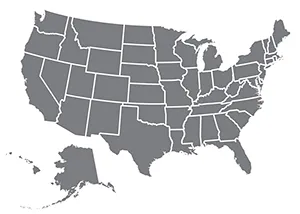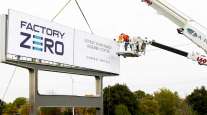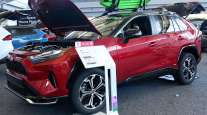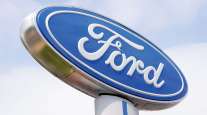The Detroit News
The EV Squeeze: How the US and Europe Compare

[Stay on top of transportation news: Get TTNews in your inbox.]
MILAN — European governments have historically been more aggressive than the United States in regulating fuel consumption with high gas taxes, favorable diesel tax breaks and escalating penalties on nonelectric automobiles.
That is about to change.
Automakers selling in the United States will face exorbitant federal fines from regulatory bodies by 2026 if they do not meet electric vehicle sales targets. Together with the goal of California — America’s largest auto market — to ban gas engine sales by 2035, that poses a significant challenge for automakers over the next decade in a market where customers prefer gas power.
“By 2026, the United States will have the most strict emissions regulations in the world along with the Netherlands and France,” said Alfa Romeo global product chief Daniel Guzzafame at the media launch of Alfa’s first electrified vehicle, the subcompact Tonale SUV. “The fines won’t be in the thousands, they will be in the millions on automakers in order to move them toward electrification.”
Unlike in Europe, however, U.S. customers are largely unaware of the costly EV transition as penalties are mostly borne by automakers — not consumers. Across the pond, by contrast, auto buyers have for years paid penalties for owning less-efficient cars — to the point where gas-powered cars are forbidden in some urban areas. In the smaller land mass of Europe, customers have the option of ubiquitous public transportation when the price of owning a car gets too high.
ELECTRIC OPTIONS: A rundown of OEMs' battery-electric choices
Yet, European governments still struggle to get consumers into EVs without massive subsidies. Italy, for example, has seen EV adoption rates stall below 4% of sales with subsidies at $3,300 per car compared to a $10,000 continent average. That has led to a push for synthetic fuels in order to keep internal combustion engines viable.
“The challenge for EV adoption is consumer anxiety,” said Stephanie Brinley, senior auto analyst for IHS Markit. “People have to make changes in their lifestyle to drive an EV, and people like their gas cars and don’t want to change.”
Crucially, the European Union’s 2035 ban on internal combustion engines includes a loophole for vehicles to burn synthetic fuels that are under development — a loophole California (and other so-called zero-emission-vehicle states that have followed its lead) have resisted in their push to eliminate ICEs by 2035.

Guzzafame via Stellantis.com
“Italy and Germany successfully won an exemption for e-fuels,” said Guzzafame, “though they will likely be very expensive.” Gasoline costs $7 a gallon in European cities like Milan.
Escalating automaker fines have already pushed brands like Dodge to eliminate such popular gas cars in the United States as the Challenger coupe and Charger sedan by the 2024 model year. Other performance models like Chevy’s Camaro are exiting the market because their thirsty V-8 engines make it hard for manufacturer fleets to satisfy government rules.
European governments also penalize automakers for emissions noncompliance (measured in carbon dioxide grams per kilometer), but consumer markets also penalize manufacturers for making thirsty vehicles. Buy a powerful 505-horsepower, 3.0-liter Alfa Romeo Giulia Quadrifoglio in Italy, for example, and you will pay a stiff 15,000-20,000 euro fine (the euro is comparable in price to the U.S. dollar) for its fuel consumption (271 g/km). Guzzafame said the Giulia would then be subject to another 3,000 euros in annual fees.
By comparison, the plug-in hybrid Tonale — Alfa’s first electrified vehicle — emits only 26 g/km on the government test and is subject to a penalty of about 1,000 euros on purchase.

Outline of the USA by bortonia/GettyImages
“A full-sized American pickup truck would be unaffordable here,” said Guzzafame, who spent years as an engineer in the United States before assuming his current role at Alfa in Italy. “It would be a luxury vehicle.”
Older, inner-city European streets are also not hospitable to the large trucks and SUVs you see on U.S. roads. But in Europe’s suburbs and rural highways, SUVs like Tonale (and Volvo XC40 and BMW X1) are common — though the SUV mix tends to be a size smaller than in the United States (America’s best-selling SUV, the midsize Toyota RAV4 SUV, is a rare large vehicle here) due to the emissions penalties and $7-a-gallon gas.
America’s single-minded push toward battery-powered vehicles is one reason Alfa is exporting only its Tonale plug-in hybrid model to the United States as a bridge to full electrification. Like other small-volume luxury brands Cadillac and Jaguar, Alfa plans to go all-electric in the United States this decade.

Brinley
“They have to go EV. It’s a demand coming from government, not consumers,” said analyst Brinley, a performance car fan herself. “Automakers recognize that enthusiasts like sound and dynamics, but it may take some time to develop EVs that people will get excited about.”
In Europe, however, Tonale will be offered in diesel and gas-hybrid versions as well as full electrics. Alfa expects the powertrain trifecta to carve the market pie in equal slices, with the hybrid leading the way.
In the 1990s, Europe’s regulatory regime favored diesel for its superior efficiency over gas (lower CO2 g/km), which led to a diesel stampede. A decade ago, some 80% of new European vehicles sold were oil-burners before Volkswagen AG’s Dieselgate scandal soured politicians and green fashion turned to battery power. Given the sheer quantity of diesel engines on the road, Europe maintains a love-hate relationship with the fuel and Italian diesel prices are typically a more affordable $6.70 a gallon compared to gasoline’s $7.30. In the United States, personal diesel transportation never took off.
Governments frown on diesels in European cities, and come 2025, diesel cars will be banned from Paris and Madrid. Other urban areas, including Milan, plan bans by 2030. Milan has a sliding Area A, B, C urban scale — with A prohibiting anything but electric cars.
Automakers like Alfa expect similar urban regulation will reach the United States, and the Tonale hybrid’s ability to run on battery power alone for 30 miles makes it compliant for highways and zero-emission cities.
Though EVs are best suited for short-range, urban environments, Italians share Americans’ cold feet for EVs. The Italian financial newspaper Il Sole 24 Ore found just 3.7% of vehicles sold in Italy in 2022 were electric — compared to 5.6% in the United States — despite Italy having the footprint of New Mexico and the population of California and New York combined.

Outline of Europe by Fourleaflover/GettyImages
Those EV sales proportions pale next to Norway’s EV new-car market share of 79%, the Netherlands’ 23% and Germany’s 18%. EVs are scarce here in Milan’s inner city, with a smattering of Tesla Model 3s and Ys and shoebox-sized Smart and Citroen Ami EVs. The generally high cost of vehicle ownership — and Italy’s dense cities — has driven many urban residents to public transit.
High EV adoption is being driven by state subsidies, say analysts, and Italy lags behind its neighbors. In Norway, government subsidies reach 50% of sticker price. The U.S. government subsidizes the purchase of EVs up to $7,500, but only 14 vehicles qualify under the complicated regulations of the Inflation Reduction Act passed last year.
“Internationally, EV incentives come in many forms, from outright subsidies to tax relief to carpool-lane access to the ability to drive into city centers,” said Anton Wahlman, an auto analyst with the financial publication Seeking Alpha. “If the consumer had to pay the real cost, EVs would be a 1% market share proposition.”
Want more news? Listen to today's daily briefing above or go here for more info
Meanwhile, America’s infatuation with hybrid Formula One racing might translate to sales as Alfa fields an F1 team with three U.S. Grand Prix on the calendar. Motorsport reflects the difference in U.S. and European approaches to zero-emissions transport.
Stefano Domenicali, CEO of Formula One — the top rung of global motorsport — has ruled out EV racing, pointing to synthetic fuels as the sport’s future. Beginning in 2026, all F1 team engines will be powered by e-fuels — one reason automakers like Ford, Audi and Cadillac have embraced F1 as a way to entertain customers while also meeting their net-zero goals.
Under F1’s new 2026 engine package, the electric motor will produce nearly half of the hybrid race car’s power — or about the same percentage the electric motor will supply to the Alfa Tonale.
Distributed by Tribune Content Agency, LLC




